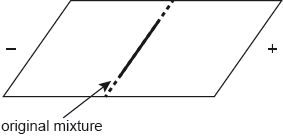| Date | November 2020 | Marks available | 2 | Reference code | 20N.3.sl.TZ0.5 |
| Level | SL | Paper | 3 | Time zone | TZ0 |
| Command term | Deduce | Question number | 5 | Adapted from | N/A |
Question
Proteins are polymers of amino acids. A paper chromatogram of two amino acids, A1 and A2, is obtained using a non-polar solvent.
© International Baccalaureate Organization 2020.
Determine the value of A1.
Proteins are polymers of amino acids.
The mixture is composed of glycine, , and isoleucine, . Their structures can be found in section 33 of the data booklet.
Deduce, referring to relative affinities and , the identity of A1.
Proteins are polymers of amino acids.
Glycine is one of the amino acids in the primary structure of hemoglobin.
State the type of bonding responsible for the α-helix in the secondary structure.
Proteins are polymers of amino acids.
Describe how the tertiary structure differs from the quaternary structure in hemoglobin.
Markscheme
✔
Accept any value within the range “”.
Ile AND larger Rf ✔
more soluble in non-polar solvent «mobile phase»
OR
not as attracted to polar «stationary» phase ✔
Only award M2 if Ile is identified in M1.
hydrogen/ bonding «between amido hydrogen and carboxyl oxygen atoms» ✔
tertiary: folding/shape of a single «polypeptide/protein» chain ✔
quaternary: arrangement/folding of four/several chains/proteins/polypeptides «held together by » ✔
Accept “two or more polypeptides” for M2.
Examiners report
Many students scored this mark. The students who missed this mark that were close either measured from the top or bottom of the spot rather than the middle. A few students had answers that were greater than 1 which indicated a clear lack of understanding of this concept.
Not well answered. Many candidates referred to glycine even when they had obtained the correct Rf value in 5a. Answers referring to Molar mass and isoelectric point were quite common. Some candidates that identified Ile correctly lost the first mark as didn't make any reference to the Rf. There was a clear lack of understanding that the Rf value was related to polarity not molar mass.
A well answered question.
Many candidates didn't understand the question and provided long answers referring to the interactions but failing to identify those took place within the same/one chain. More candidates were able to score the second mark referring to multiple chains.


